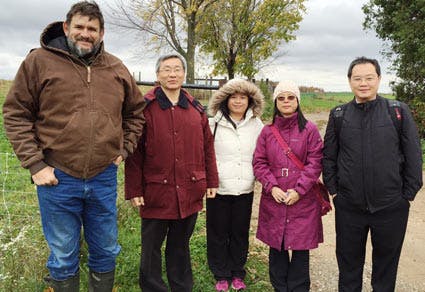Audit Team from Taiwan Examines U.S. Lamb Industry

Michigan State University Sheep Farm Manager Alan Culham (far left) provides Taiwanese officials with a tour of the operation near East Lansing, Michigan
A group of Taiwanese agricultural and health officials is in the United States this week to evaluate the U.S. lamb production and processing system. U.S. lamb currently lacks access to a number of international markets, including Taiwan, due to scrapie-related restrictions introduced in response to the 2003 BSE case.
“Regaining access to high-value Asian markets is a top priority for the U.S. lamb industry,” said Dennis Stiffler, Ph.D., of Mountain States Rosen, who represents the lamb producing and feeding sector on the USMEF Executive Committee. “Taiwan would be an excellent addition to the international destinations for U.S. lamb, and this evaluation is an important step toward that goal.”
The delegation’s first stop was in Washington, D.C., for meetings with USDA officials. Next they traveled to East Lansing, Michigan, for a tour of the Michigan State University Sheep Teaching and Research Center and an overview of the U.S. sheep and lamb industry with Dr. Richard Ehrhardt, small ruminant extension specialist. They also toured the Hannewald Feedlot near Stockbridge, Michigan, for a firsthand look at a lamb feeding operation.
On Wednesday the team traveled to Colorado to tour several lamb processing facilities, including the Greeley operations of Mountain States Rosen and JBS, and the Superior Farms Colorado plant in Denver. Their evaluation concludes early next week in California with a tour of Superior Farms facilities in Dixon and a visit to the FSIS Western Laboratory in Alameda.
“The objective is to give Taiwanese officials a thorough overview of the U.S. lamb production model, so they can see firsthand our feeding and processing safeguards and other measures that ensure we are providing their consumers with a very safe, high-quality product,” explained Travis Arp, USMEF technical services manager. “Getting them inside the plants and production facilities is an essential part of that process.”
Last year Taiwan imported 15,321 metric tons of lamb and mutton, valued at about $60 million, with the market split fairly evenly between Australia and New Zealand. The U.S. industry’s focus is to capitalize on demand from Taiwan’s high-end foodservice establishments.
“The hotel and restaurant sector presents excellent opportunities for grain-fed lamb, where Taiwanese consumers clearly have a taste for well-marbled, high-quality cuts,” Arp said.
